This is the third article in XM Institute’s series on XM Technology.
In the first article, Introducing the Four Technology Pillars of an Effective XM Platform, we outlined the critical role an Experience Management (XM) Platform plays in today’s challenging business environment – serving as a central nervous system that allows the organization to continuously sense, interpret, and respond to its environment. In part two of this series, we explored The Technological Capabilities that Power an XM Platform, examining which features and capabilities a platform needs to continuously capture, analyze, and act upon XM data – all while ensuring scalability and integration with the broader enterprise ecosystem. Building on this foundation, this article explores how these capabilities evolve over time as they progress through five levels of Technology Maturity.
XM Technology Maturity Doesn’t Happen Overnight
The goal of Experience Management is to build a foundation for agility, innovation, and competitive advantage in an era where human experience is the ultimate differentiator. Long-term XM success requires a systematic focus on driving enterprise-wide change over multiple years. To help guide these efforts, XM Institute created the XM Operating Framework, a blueprint organizations can follow to master the discipline of Experience Management by maturing their XM Technology, Culture, and Competencies. The Technology element – which refers to the platform that allows XM practices to scale consistently across an organization – is essential for generating and disseminating the XM insights that fuel this experience-centric transformation. Without it, the organization won’t be able to create a shared, holistic understanding of people’s experiences, which provides the necessary foundation for XM-centric Culture and Competencies to flourish.
However, building a successful, sustainable Experience Management program does not happen overnight. It requires a multi-year strategy focused on simultaneously maturing XM Technology, Culture, and Competencies – along with the continued support of strong executive Ambition. As an organization progresses up the maturity curve, its XM program will increasingly deliver on the business value and transformative potential of Experience Management efforts.
To guide organizations along this journey, we’ve defined five levels of XM Technology maturity, which they evolve through as their capabilities become progressively more sophisticated and integrated into their operations. This framework provides organizations with a roadmap they can follow to implement the technological capabilities necessary for achieving their XM vision and goals. It offers a structured approach for evaluating their XM Technology’s current strengths and weaknesses, and it provides XM professionals with a communication tool they can use to build buy-in and alignment with stakeholders. While not a rigid blueprint, the five levels of XM Technology maturity we’ve commonly observed organizations advance through are:
- Level 1: Fragmented. Scattered teams use different technologies with basic capabilities.
- Level 2: Foundational. As XM Technology usage becomes more widespread, the organization begins investing in the underlying infrastructure to manage relevant insights and actions.
- Level 3: Unified. The organization starts centralizing XM data, creating a shared understanding of experiences and enabling insights-driven actions across channels and teams.
- Level 4: Integrated. The organization embeds the XM Platform into its core business processes, driving real-time actions and personalized experiences.
- Level 5: Transformational. The XM Platform is a mission-critical technology that leverages sophisticated AI capabilities to continuously improve its performance and optimize outcomes in real-time.
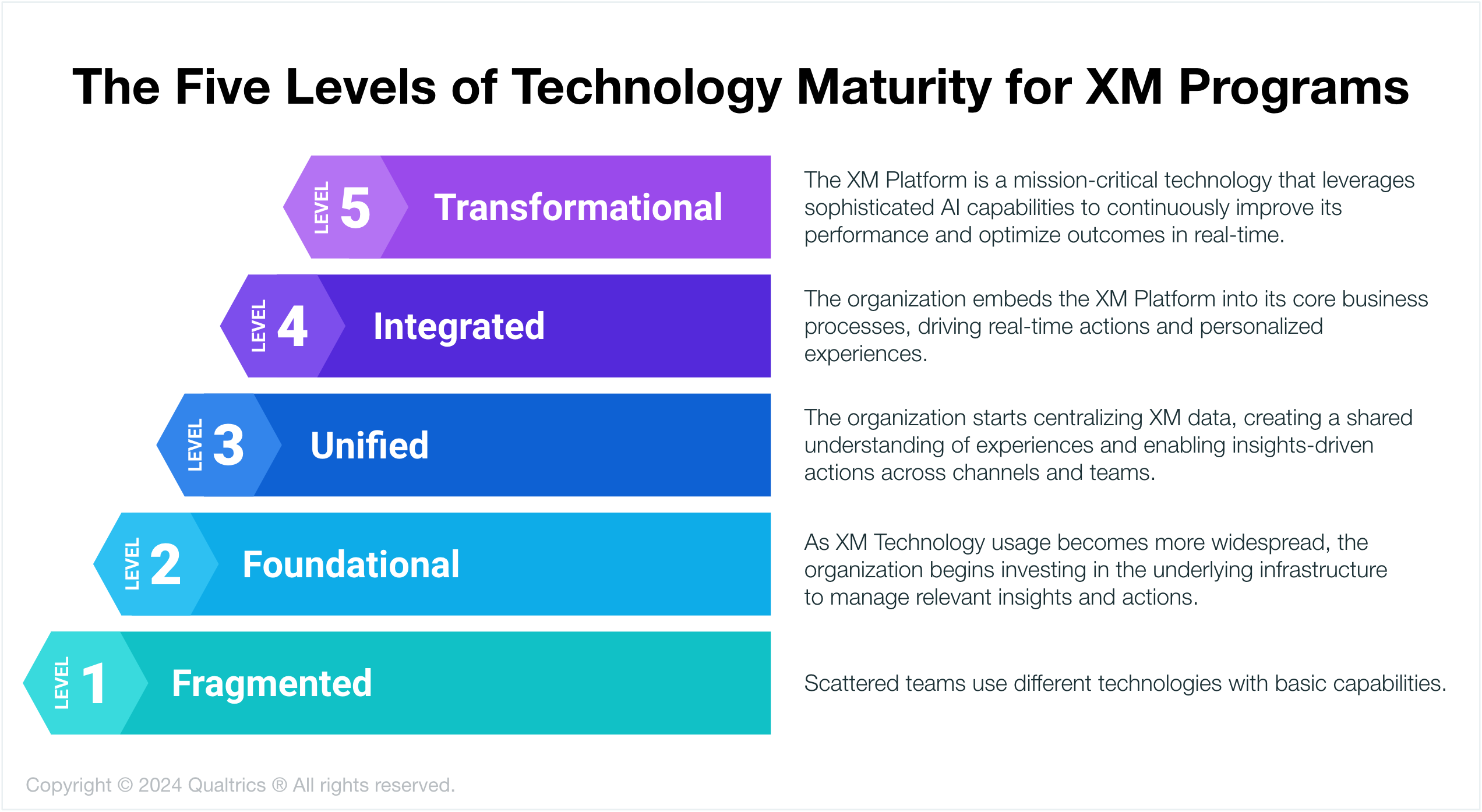
Level 1: Fragmented
Scattered teams use different technologies with basic capabilities.
The organization does not yet understand the financial or strategic value of Experience Management. So although isolated teams may be working on some experience-adjacent activities (like customer service, user experience, or employee engagement studies), each group uses its own technologies and vendors to capture and share data. This results in a fragmented XM Technology ecosystem, where relevant information remains isolated in siloed business systems that are owned by different teams.
The XM technologies that are used mostly offer basic capabilities designed to help analysts create, deploy, and interpret surveys. These surveys capture structured feedback – often in the form of multiple-choice responses – at predetermined points along someone’s journey, like a post-event satisfaction survey or an annual NPS or engagement study. Results are manually analyzed and distributed to just a few stakeholders through static dashboards, decks, or spreadsheets.
Common obstacles we see organizations encounter as they try to derive business value from their XM Technology at this level include:
- Insufficient information. The scattered nature of XM technologies and data leads to an incomplete and narrow understanding of people’s experiences, making it difficult to uncover issues and opportunities, allocate resources effectively, and make data-driven decisions.
- Delayed fixes. Reliance on manual processes and anecdotal evidence creates a reactive, delayed approach to problem-solving, leading to slow issue resolution, experience gaps, and suboptimal fixes.
- Difficulty scaling improvements. Disconnected XM technologies make it hard to scale experience improvements across departments or touchpoints, limiting the impact of these changes and creating inconsistent experiences across channels.
- Operational inefficiencies and risks. Manual processes, data fragmentation, and the absence of centralized controls lead to wasted resources, duplicated efforts, and increased risks related to data quality, security, and compliance, which can negatively impact the organization’s bottom line and reputation.
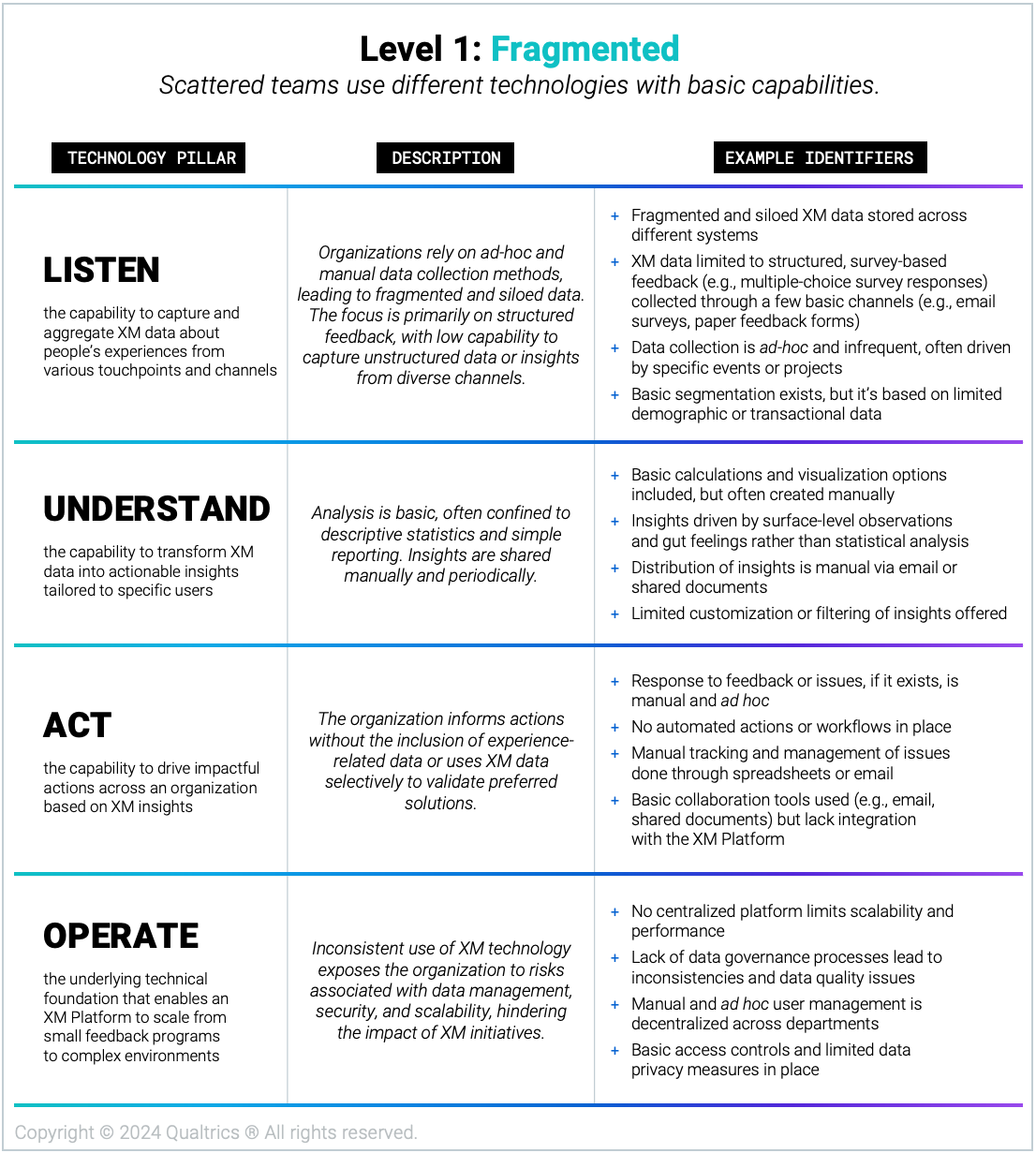
Level 2: Foundational
As XM Technology usage becomes more widespread, the organization begins investing in the underlying infrastructure to manage relevant insights and actions.
Teams are starting to recognize the value of XM. As a result, pockets of the organization have adopted a preferred XM Platform dedicated to capturing and managing their XM data. While their scope remains limited – often only serving a single department or channel and housing only experience data – these platforms do enable a more formalized and consistent approach to XM. For example, data collection has become more regular and now expands across multiple channels, such as post-support surveys sent through email and SMS or digital feedback collected through passive listening tabs and active intercepts.
Teams use these platforms for basic analytics (like descriptive tools) and statistical techniques that provide insights into key metrics and trends. They then share these insights out through static dashboards and simple alerts with a limited set of users, such as the frontline or people managers. Basic workflows are in place but designed to trigger notifications rather than drive action. However, basic integrations with other business systems start laying the groundwork for more automated, cross-functional responses to XM insights in the future.
Common obstacles we see organizations encounter as they try to derive business value from their XM Technology at this level include:
- Data silos and gaps. The inconsistent adoption of the XM Platform(s) and continued focus on capturing periodic, structured feedback create data silos and gaps in understanding, limiting organizational visibility into people’s end-to-end journeys and impeding cross-functional collaboration.
- Surface-level analysis. Basic analytics and reporting capabilities provide a limited understanding of key metrics and trends but fail to uncover deeper, predictive insights or identify root causes of issues, leading to superficial fixes that may not address underlying problems or drive significant improvements.
- Limited access to insights. Static dashboards and limited reporting options restrict access to and usability of XM insights, limiting their impact on decision-making and preventing broader organizational engagement with XM data.
- Resource inefficiencies. The use of multiple XM technologies, manual processes, and lack of standardized feedback loops create inefficiencies in resource allocation, both in terms of financial investment and employee time.
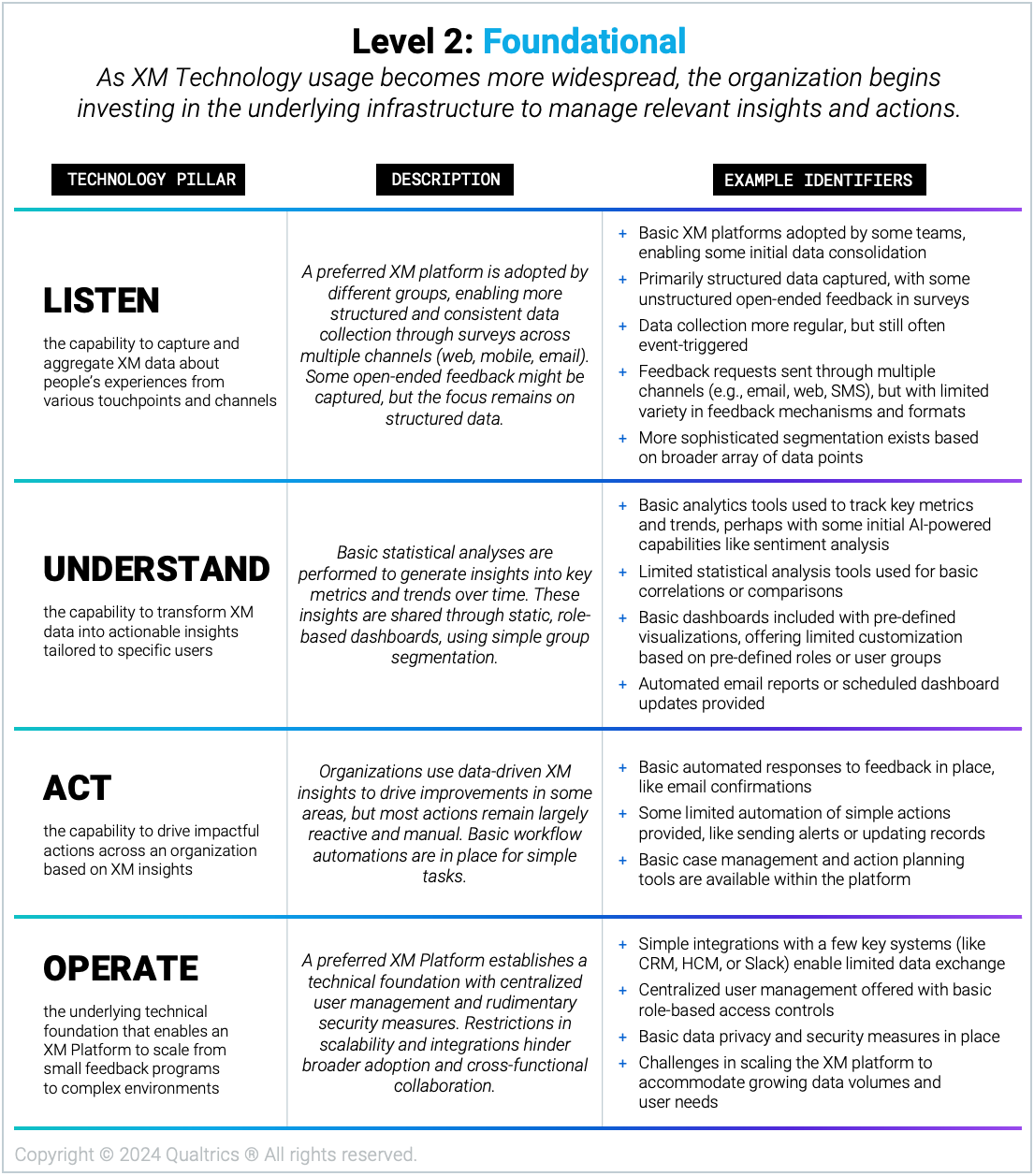
Level 3: Unified
The organization starts centralizing XM data, creating a shared understanding of experiences and enabling insights-driven actions across channels and teams.
Once the organization views XM as a strategic priority, it starts bringing all its disparate XM data together in one place, creating a single source of truth across touchpoints. Here, XM data includes experience, behavioral, and operational data in structured and unstructured formats from a range of listening channels, both solicited and unsolicited. This serves as a foundation for personalized interactions, communications, and recommendations. Creating this single source of truth often entails aggregating XM data from different business systems onto a single, enterprise-wide XM Platform – although the exact architecture will depend on things like the organization’s structure and tech stack.
Once the organization has this comprehensive, omnichannel view of people’s experiences, it accelerates their capabilities across a number of different dimensions. It enables teams to cross-functionally coordinate their listening strategies, collecting data more continuously and proactively with some more sophisticated personalization capabilities. The XM Platform’s advanced analytics – including some AI and ML capabilities – uncover deeper, predictive insights. These insights are shared through customized, automated reporting mechanisms, like dynamic dashboards or personalized alerts. They also automatically trigger workflows (like closed-loop follow up) and initiate timely XM-centric actions across the entire organization. All these capabilities are supported by the XM Platform’s increasing number of integrations with other systems, which allow for inbound and outbound flows of data. This is where the organization will begin exploring AI and ML use cases through some of the AI-Powered capabilities under Listen, Understand, and Act.
Common obstacles we see organizations encounter as they try to derive business value from their XM Technology at this level include:
- Data overload. The sudden increase in the volume of XM insights, often without clear prescriptive guidance, can overwhelm organizations, leading to challenges in identifying and prioritizing the most critical signals, analysis paralysis, and unrealized improvement or innovation opportunities.
- Limited real-time personalization. While the unified XM platform enables some more advanced personalization, reliance on static, rule-based segmentation constrains its ability to dynamically adapt experiences and insights in real-time based on individual context, needs, and behavior, which results in less relevant and impactful interactions.
- Incomplete integrations. The XM platform, though centralized, is still primarily used by frontline teams and not yet fully integrated into the entire technology ecosystem. This results in missed opportunities to leverage data from other systems, trigger automated actions in those systems, and create truly seamless and connected experiences.
- Nascent AI and ML adoption. Although the organization has begun exploring AI and ML use cases (like conversational analytics, simple predictive models, and rules-based automations), these efforts remain limited in scope and sophistication. They still require significant manual oversight and don’t yet harness the full potential of these technologies for deeper insights, advanced automation, and hyper-personalization.
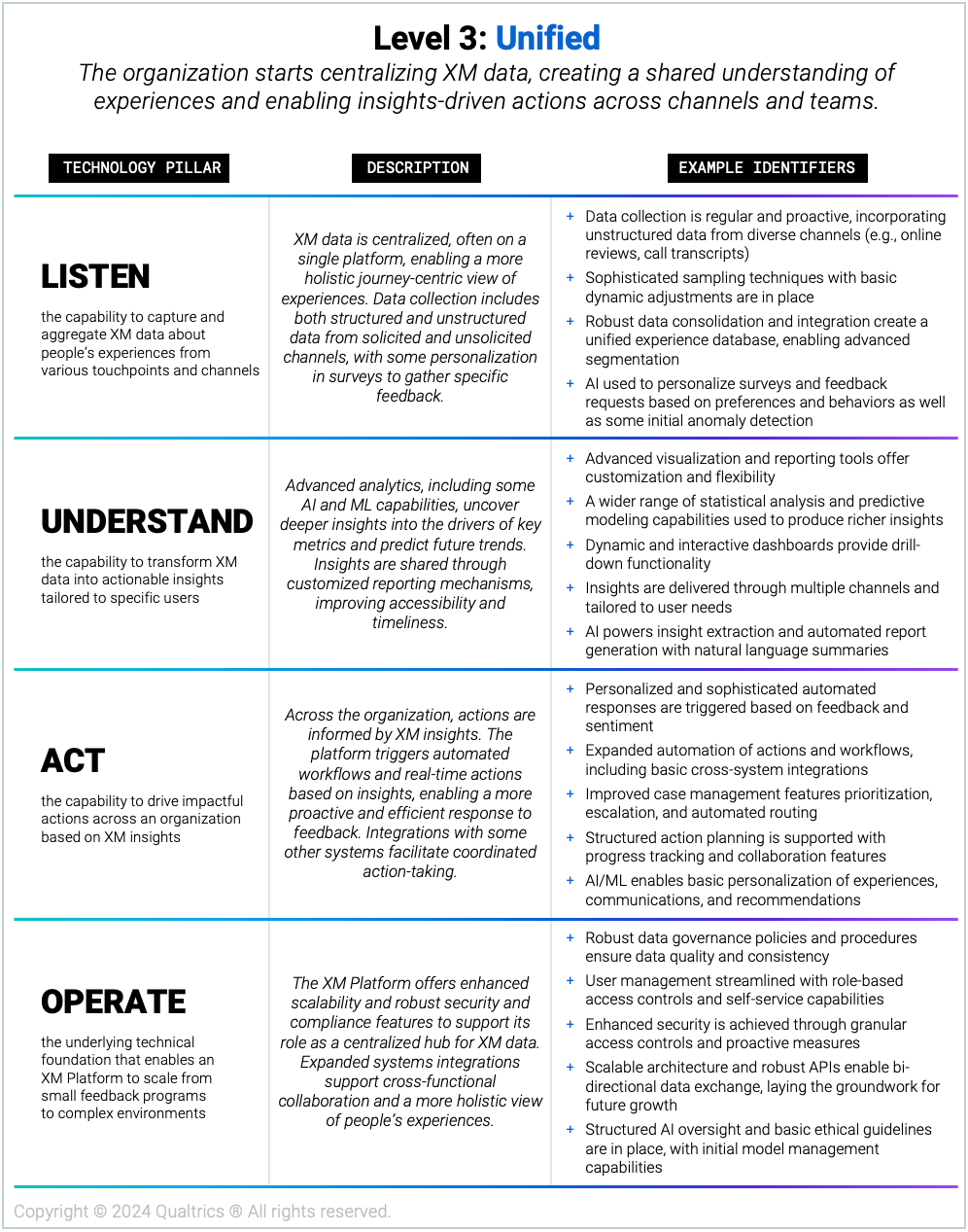
Level 4: Integrated
The organization embeds the XM Platform into its core business processes, driving real-time actions and personalized experiences.
In this later stage of maturity, the organization deploys an integrated and scaled XM Platform that infuses XM insights into all its core systems and processes. This enables real-time, data-driven actions and the delivery of proactive, personalized experiences at scale. Through its extensive integrations, the platform is able to provide a comprehensive, continuously updated view of individuals and their end-to-end journeys, drawing on real-time XM data streams from diverse sources. It can also dynamically adapt its listening activities to capture the data that is most relevant at a given moment for both the organization and respondents, such as tailoring survey questions based on someone’s unique behaviors, preferences, or context.
Organizations at this level are strategically deploying numerous AI-Powered capabilities for XM. Advanced, AI-powered analytics transform XM data into predictive, prescriptive, and personalized insights. The platform here goes beyond just sharing scores; it delivers contextual guidance and actionable recommendations through various reporting mechanisms (e.g., dynamic dashboards, real-time alerts, and AI-generated summaries), all designed to accelerate and support an employee’s decisions. Automated workflows, triggered by XM insights or events, streamline processes, while AI-powered segmentation enables the personalization of experiences at every touchpoint – from tailoring marketing communications to individualized employee coaching. The platform is capable of addressing the complexities of all these different AI deployments, ensuring things like data security, insight reliability, and effective model management.
Common obstacles we see organizations encounter as they try to derive business value from their XM Technology at this level include:
- Challenges with emerging data integration. The rapidly evolving data landscape presents difficulties in proactively identifying and seamlessly integrating new data sources or signals into the platform, potentially limiting the depth and breadth of insights available for decision-making.
- Residual manual processes. Despite extensive automation, certain platform functionalities or processes may still require manual intervention or lack real-time responsiveness, hindering the organization’s ability to fully capitalize on the potential for proactive and predictive actions.
- Interpretability of AI and ML models. As AI/ML models become more complex, their inner workings can become less transparent, making it difficult to understand why certain insights or recommendations are generated. This can lower trust and adoption of XM insights, especially in critical decision-making scenarios.
- Organizational barriers to agility. Even with a highly integrated XM platform, organizational structures, processes, or mindsets may not be fully aligned for rapid adaptation and innovation at scale, slowing down the ability to respond to market shifts and tap into the platform’s full potential.
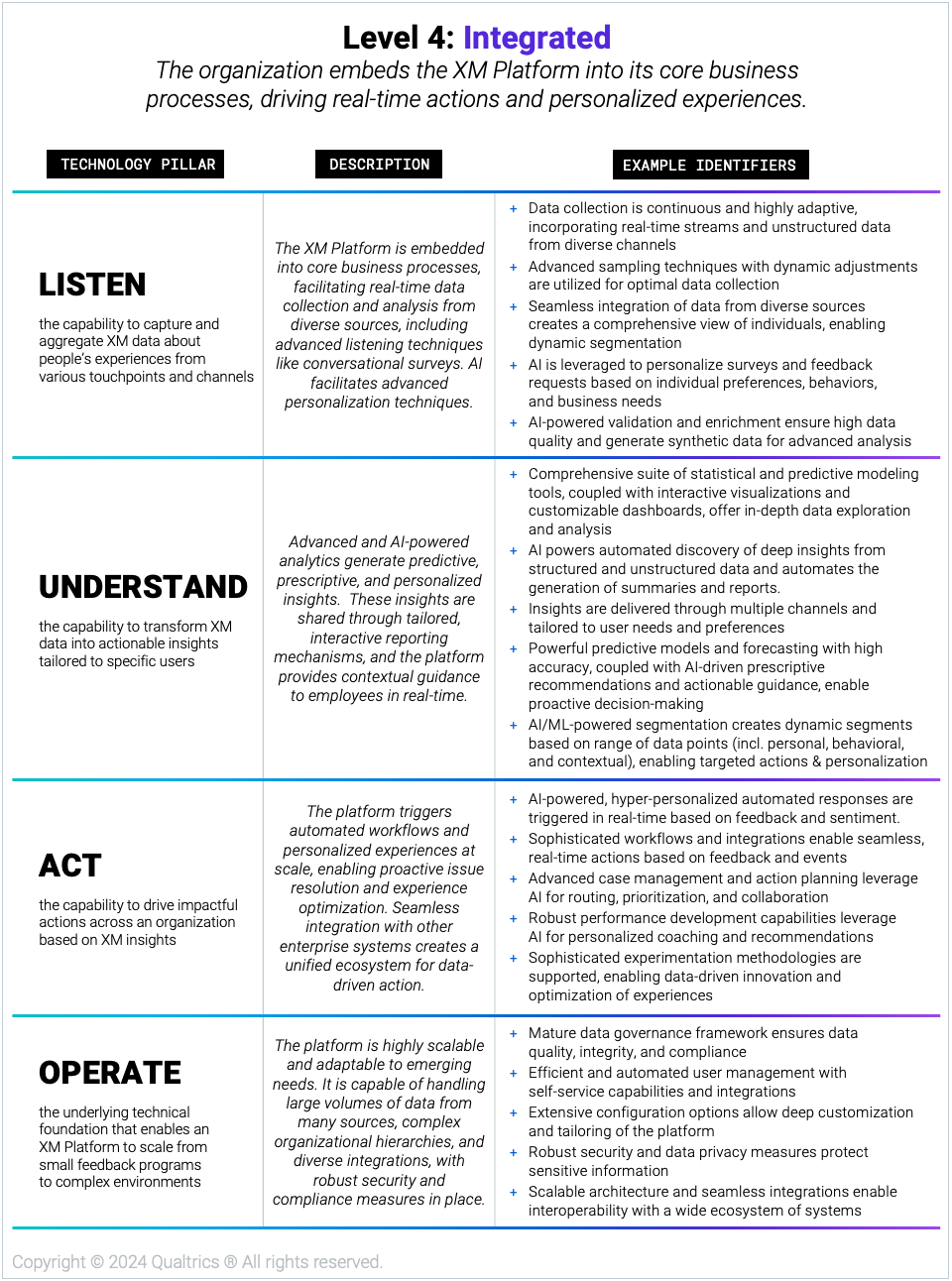
Level 5: Transformational
The XM Platform is a mission-critical technology that leverages sophisticated AI capabilities to continuously improve its performance and optimize outcomes in real-time.
At this pinnacle of XM maturity, the organization fully embraces XM as a strategic imperative, with the XM Platform becoming a self-learning, AI-driven engine for proactive and predictive Experience Management. It is able to continuously collect and analyze real-time data from all channels, generating deep insights into perceptions, behaviors, and trends. This empowers the platform to trigger immediate, personalized actions and adapt feedback mechanisms on the fly, ensuring high levels of relevance and engagement. Deep integrations with other enterprise systems facilitate seamless data flow and automated responses, which ultimately creates a truly unified ecosystem.
The platform also transcends traditional analytics, acting as a strategic advisor that proactively recommends actions and predicts outcomes based on complex scenarios and simulations. Because its AI models continuously learn and adapt, the platform is able to provide increasingly accurate and nuanced insights that anticipate future needs and trends. This produces a holistic XM system that not only optimizes experiences in real-time but also drives continuous innovation by proactively identifying and addressing emerging issues. The organization, empowered by this intelligent platform, achieves unparalleled agility and consistently exceeds people’s expectations, securing the competitive advantages crucial for success in today’s rapidly evolving business landscape.
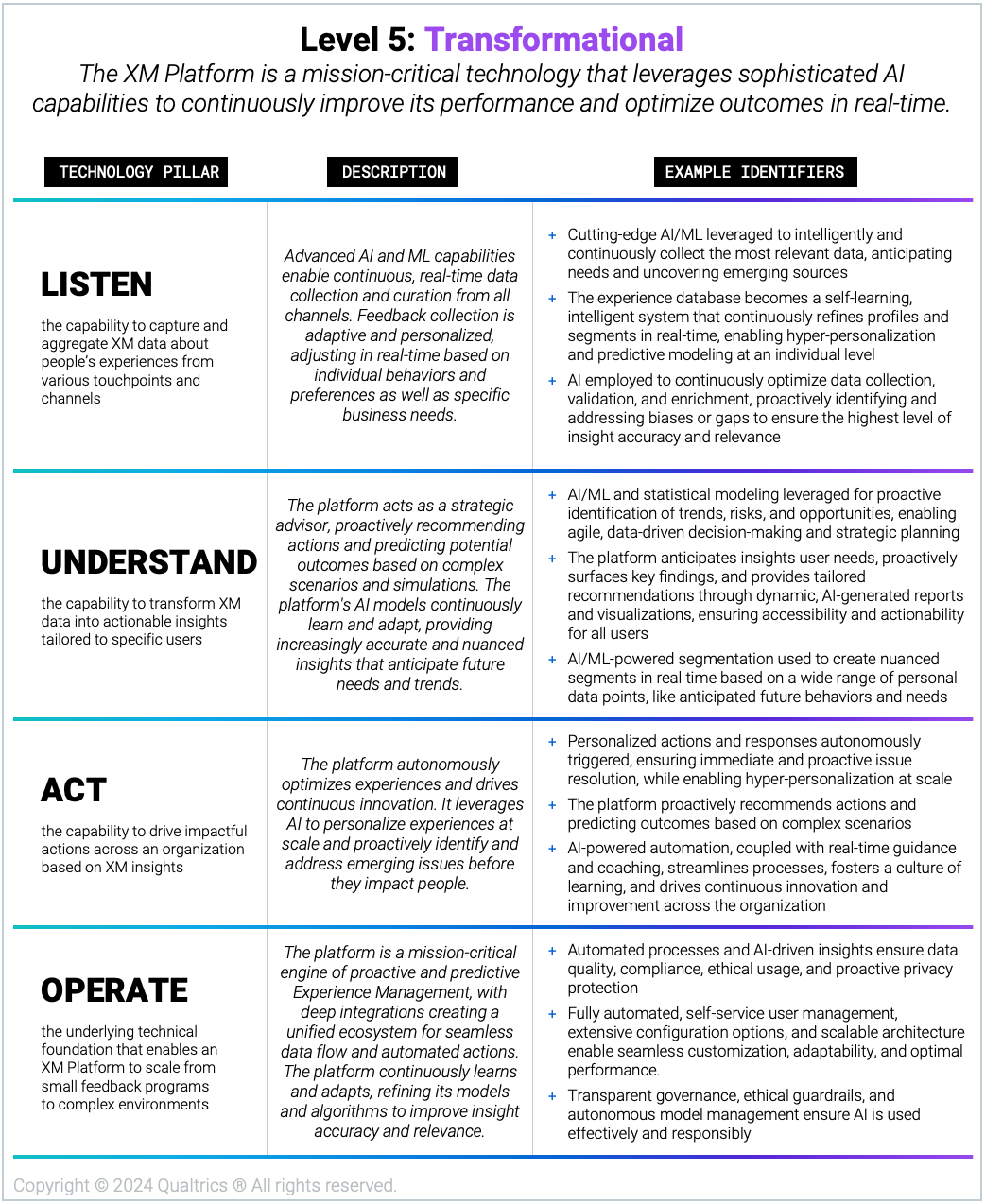
Bottom Line: Use the Five Levels of XM Technology Maturity as a guide to help you understand which technological capabilities you need in place to achieve your XM vision.
Isabelle Zdatny, XMP, CCXP, is Head of Thought Leadership for Qualtrics XM Institute
Dr. Juliana Smith Holterhaus, Ph.D., is a Senior Product XM Scientist with Qualtrics, specializing in Digital XM
Drew Green, XMP, Senior XM Scientist & Global Digital Advisory Lead
Dr. Cecelia Herbert, XMP, PsyD, is a Principal Behavioural Scientist with Qualtrics XM Institute





